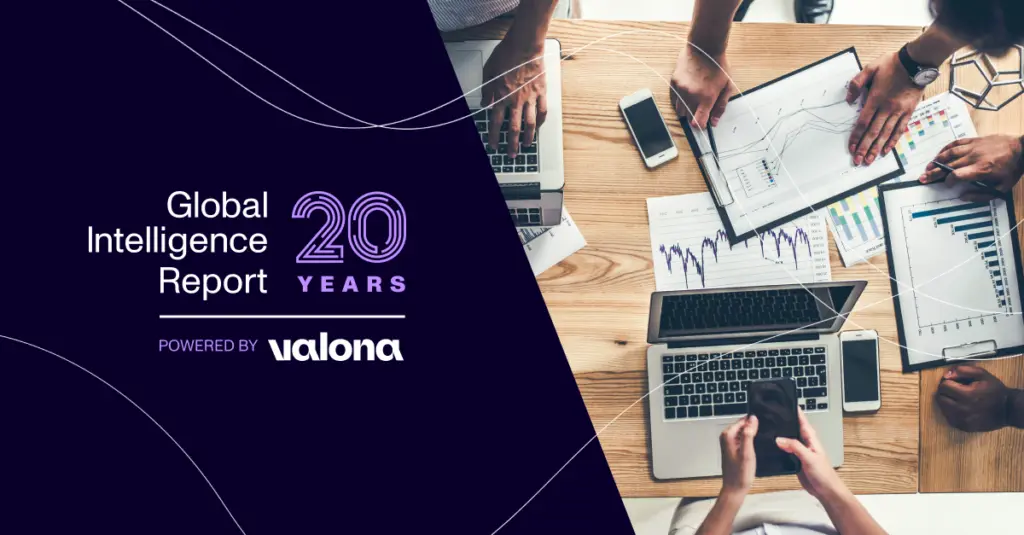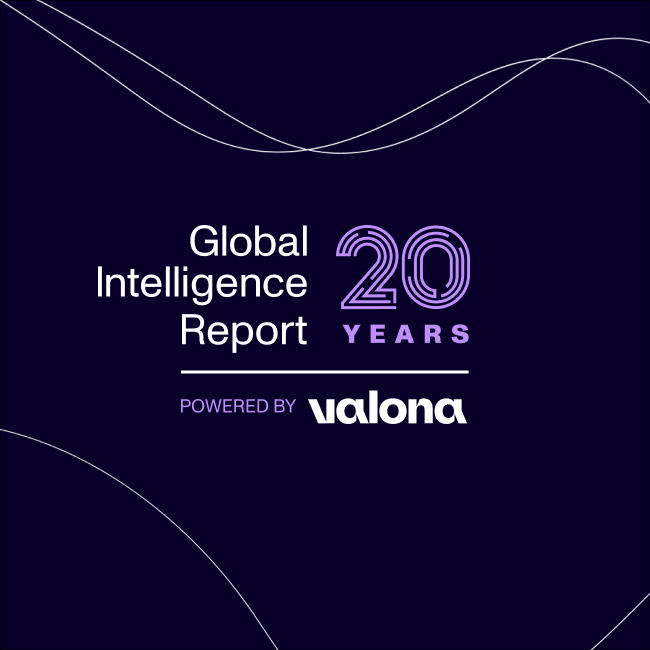
The Strategist’s Toolkit: 5 Proven Strategic Foresight Methods for Uncertain Times
Strategic foresight methods deliver measurable results—future-prepared firms are 23% more profitable. Learn the 5 essential techniques that transform how organizations navigate uncertainty.
This article is based on insights from our recent webinar “How to Use Foresight and Forecasting for a Strong 2025” featuring strategic foresight expert Sakari Nisula.
The fall of Blockbuster and rise of Netflix stands as perhaps the most dramatic illustration of strategic foresight methods in motion. While Blockbuster relied on historical data that showed customers reliably returning to browse the new release racks every Friday night, Netflix was looking ahead — and spotting a completely different set of signals on the horizon.
These signals included rising frustration with late fees, accelerating broadband internet adoption in American homes, and companies like Apple shifting music from physical to digital formats.
By connecting these seemingly unrelated dots, Netflix first pioneered DVD-by-mail, then invested $40 million to develop streaming technology years before the market demanded it. While Blockbuster’s CEO famously laughed in 2000 when offered the chance to buy Netflix for $50 million. But by 2010 Blockbuster had filed for bankruptcy—and Netflix had created the foundation for what would become a $250 billion entertainment powerhouse.
The difference wasn’t luck—it was Netflix’s deliberate application of strategic foresight methods that Blockbuster chose to ignore.
This pattern appears consistently across industries. Research shared in our recent webinar revealed that companies employing strategic foresight methods outperform peers by a significant margin, with “future-prepared firms” achieving 23% higher profitability than industry averages.
The limitations of traditional forecasting
Traditional forecasting serves an important purpose in stable environments, but it creates significant vulnerabilities in our increasingly complex business landscape. When we rely exclusively on past trends, we miss the disconnects and non-linear changes that often reshape entire industries.
As Sakari Nisula, strategic foresight specialist, explained during the webinar:
“The proper response to radical change is not to redouble our efforts to predict an unknowable future, but to develop strategies that are robust and resilient to events which we cannot anticipate.”
This fundamental insight explains why traditional forecasting proves inadequate when navigating:
- Geopolitical tensions that rapidly reshape global markets – Consider how quickly European energy companies had to pivot when Russia-Ukraine tensions disrupted natural gas supplies in 2022, leaving unprepared firms facing existential crises while those with strategic foresight had already diversified their supply chains
- Technological breakthroughs that create new competitive landscapes – When generative AI emerged in late 2022, companies with established horizon scanning practices were already experimenting with implementation, while organizations relying on traditional forecasting were caught flat-footed, scrambling to catch up months later
- Regulatory shifts that transform industry economics – Financial services firms that anticipated ESG reporting regulations through scenario planning were implementing systems ahead of mandates, while competitors faced costly rush implementations and compliance penalties
- Evolving consumer values that redefine market expectations – Brands that detected early signals of changing sustainability preferences among millennials and Gen Z gained significant market share, while companies relying on historical consumer data struggled to understand why long-loyal customers were suddenly switching
- Supply chain vulnerabilities exposed by global disruptions – Manufacturers who had used cross-impact analysis to examine the interconnections between pandemic risks, trade tensions, and shipping infrastructure outperformed competitors by securing alternative suppliers and inventory positions before bottlenecks became obvious
In our webinar poll, participants identified geopolitics, AI advancement, and sustainability pressures as their primary concerns for 2025—all domains characterized by complex, non-linear change that traditional forecasting struggles to address.
The organizations gaining competitive advantage today don’t simply gather more data; they identify patterns across seemingly unrelated developments and take strategic action before these patterns become obvious to competitors.
Five strategic foresight methods that drive market leadership
The webinar highlighted five strategic foresight methods that transform how organizations navigate uncertainty and maintain competitive advantage:
1. Horizon Scanning: Detecting signals before they hit the headlines
Horizon scanning provides a systematic approach for identifying early indicators of change before they manifest as obvious market trends. Unlike conventional market research, effective horizon scanning extends beyond your immediate industry to identify emerging patterns across political, economic, social, technological, environmental, and legal domains.
Implementation process:
- Establish a structured process for capturing diverse signals from multiple sources
- Engage cross-functional teams to bring complementary perspectives to the analysis
- Develop filtering mechanisms that separate meaningful signals from background noise
- Integrate findings into strategic discussions rather than treating them as separate inputs
This insight explains why traditional forecasting proves inadequate when navigating:
- Geopolitical tensions that rapidly reshape global markets
- Technological breakthroughs that create new competitive landscapes
- Regulatory shifts that transform industry economics
- Evolving consumer values that redefine market expectations
- Supply chain vulnerabilities exposed by global disruptions
In our webinar poll, participants identified geopolitics, AI advancement, and sustainability pressures as their primary concerns for 2025—all domains characterized by complex, non-linear change that traditional forecasting struggles to address.
The organizations gaining competitive advantage today don’t simply gather more data; they identify patterns across seemingly unrelated developments and take strategic action before these patterns become obvious to competitors.
Five strategic foresight methods that drive exceptional performance
During the webinar, Sakari highlighted five strategic foresight methods that transform how organizations navigate uncertainty and maintain competitive advantage:
1. Horizon Scanning: Detecting signals before they become obvious
Horizon scanning provides a systematic approach for identifying early indicators of change before they manifest as obvious market trends. Unlike conventional market research, effective horizon scanning extends beyond your immediate industry to identify emerging patterns across political, economic, social, technological, environmental, and legal domains.
Implementation approach:
- Establish a structured process for capturing diverse signals from multiple sources
- Engage cross-functional teams to bring complementary perspectives to the analysis
- Develop filtering mechanisms that separate meaningful signals from background noise
- Integrate findings into strategic discussions rather than treating them as separate inputs
“Change rarely emerges from within an industry alone,” Nisula explained during our session. “Disruptive trends, emerging technologies, and shifting societal values often originate from other sectors or broader macro-level forces.”
2. Scenario Planning: Preparing for an unknowable future
Scenario planning acknowledges fundamental uncertainty by developing multiple plausible futures rather than betting everything on a single forecast. This method helps organizations prepare for a variety of potential outcomes while identifying robust strategies that perform well across different conditions.
Effective scenario planning typically creates 3-4 distinct, plausible futures that challenge current assumptions and expand strategic thinking. The goal isn’t predicting which scenario will materialize, but developing adaptable strategies that remain effective across multiple potential environments.
Implementation approach:
- Identify the 2-3 most critical uncertainties facing your industry
- Explore different combinations of these uncertainties to create distinct scenarios
- Develop detailed narratives for each scenario, including business implications
- Test current strategies against these scenarios to identify vulnerabilities
- Design flexible approaches that can adapt as conditions evolve
“These scenarios should be different, impactful, and even provocative,” Nisula emphasized, noting that effective scenarios create distinct strategic challenges requiring different responses.
3. Backcasting: Mapping the path to preferred futures
While forecasting attempts to predict future states based on current trends, backcasting inverts this approach by starting with a clearly defined vision and working backward to identify the necessary steps to achieve it.
This strategic foresight method excels when addressing transformational goals like sustainability initiatives, digital transformation, or market expansion where the destination is clear but the path forward contains significant complexity.
Implementation approach:
- Define a specific, detailed vision of your desired future state
- Identify the major milestones required to reach that vision
- Determine the capabilities, resources, and partnerships needed for each milestone
- Create a structured roadmap with concrete actions toward your long-term objective
- Regularly review and adjust the roadmap as conditions evolve
During our webinar, Sakari Nisula observed that while many companies develop scenarios, they often underinvest in defining their preferred future: “Companies are building scenarios… but using maybe a little time on what is our preferred future and what has to happen to get there.”
Backcasting provides particular value in ensuring that day-to-day decisions consistently align with long-term strategic objectives rather than being diverted by immediate concerns.
4. Cross-Impact Analysis: Understanding trend interactions
Most organizations track individual trends, but few systematically analyze how these trends influence and amplify each other. Cross-impact analysis reveals these interconnections, helping leaders understand complex cause-and-effect relationships that might otherwise remain hidden.
This method acknowledges that trends rarely exist in isolation. A technological breakthrough might trigger regulatory responses, which influence consumer behavior, potentially creating entirely new market dynamics. Understanding these relationships enables more sophisticated strategic planning.
Implementation approach:
- Identify key trends affecting your business environment
- Create a matrix showing how each trend might impact others
- Assess whether trends reinforce each other, counteract each other, or create new dynamics
- Identify trend clusters that could create significant disruption or opportunity
- Develop strategies that address these interconnections rather than isolated trends
5. Delphi Method: Structured expert consensus building
The Delphi method systematically gathers and refines expert opinions through structured feedback rounds, helping to reduce cognitive bias and build informed consensus around complex future developments.
Unlike traditional expert panels or focus groups, this strategic foresight method maintains anonymity between participants, prevents dominant voices from disproportionately influencing outcomes, and encourages experts to revise their views based on collective insights.
Implementation approach:
- Select a diverse panel of experts with complementary backgrounds and viewpoints
- Conduct multiple rounds of anonymous questionnaires on key topics
- Share summarized results with participants between rounds
- Allow experts to refine their perspectives based on group feedback
- Analyze the final consensus and areas of disagreement for strategic insights
This approach proves particularly valuable for issues where expert judgment is essential but traditional quantitative forecasting falls short—such as emerging technologies, evolving geopolitical risks, or shifting market preferences.
Implementing strategic foresight in your organization
Understanding these strategic foresight methods represents only the initial step. The real value comes from implementation—integrating these approaches into your organization’s planning and decision-making processes.
Effective implementation typically follows these principles:
- Start selectively – Begin with the one method most relevant to your current strategic challenges
- Leverage existing resources – Use available information, research, and tools rather than building everything from scratch
- Focus on decisions – Ensure foresight activities directly connect to strategic choices and resource allocation
- Communicate broadly – Share findings throughout your organization to build awareness and engagement
- Embrace diversity of thought – Include perspectives from different functions, backgrounds, and thinking styles
“Foresight is not done for its own sake, but for making better business decisions about the future.”
Sakari Nisula
The Competitive Advantages of Strategic Foresight
Organizations that effectively implement these strategic foresight methods consistently achieve several distinct advantages:
- Enhanced resilience – Anticipating potential disruptions enables proactive adaptation rather than reactive crisis management
- Innovation leadership – Identifying emerging needs and technologies before competitors creates first-mover advantage
- Resource optimization – Understanding long-term trends prevents investment in soon-to-be-obsolete initiatives
- Superior risk management – Comprehensive understanding of potential futures improves contingency planning
- Strategic alignment – Shared perspectives on possible futures align teams around common directions and priorities
During our webinar polling, participants identified “seizing competitive advantage” and “enhancing organizational resilience” as the primary benefits they sought from strategic foresight methods. Research confirms that companies employing these approaches consistently outperform their industry peers.
Elevate Your Strategic Intelligence Capabilities
Valona’s intelligence platform significantly enhances your ability to implement these strategic foresight methods through:
- AI-powered trend monitoring across 200,000+ sources in 115+ languages
- Customizable dashboards for tracking emerging signals relevant to your industry
- Collaborative tools for scenario development and expert input
- Seamless integration with existing strategic planning processes
[SCHEDULE A PERSONALIZED DEMO] to discover how Valona helps organizations implement these strategic foresight methods and transform uncertainty into competitive advantage.
Valona Intelligence has been helping Fortune 500 companies navigate complex business environments since 1999. Our platform combines advanced AI with human expertise to deliver actionable intelligence that drives market leadership.
Strategic Foresight Method FAQS
How can these strategic foresight methods be integrated with our existing planning processes?
Integration often begins by incorporating one method—such as horizon scanning or scenario planning—into your regular strategic review cycles. For example, you might add a horizon scanning report to quarterly business reviews or use scenario planning to test the robustness of your annual strategic plan. As your organization becomes comfortable with these approaches, you can gradually introduce additional methods.
What distinguishes strategic foresight from traditional forecasting?
While forecasting attempts to predict a single future based on historical data and current trends, strategic foresight acknowledges fundamental uncertainty by exploring multiple possible futures. This approach helps develop strategies that remain robust across different potential environments. Forecasting works well for short-term, predictable conditions, while strategic foresight proves essential for navigating long-term uncertainty.
How can we measure the value of implementing these methods?
The most direct measure comes through improved decision quality over time, but organizations also track metrics such as innovation output, reduced strategic surprises, improved time-to-market for new offerings, and enhanced strategic agility. Research demonstrates that “future-prepared” firms consistently achieve 23% higher profitability than industry averages.




